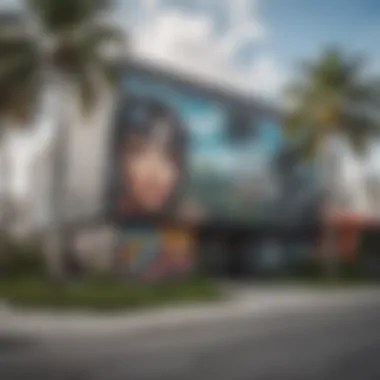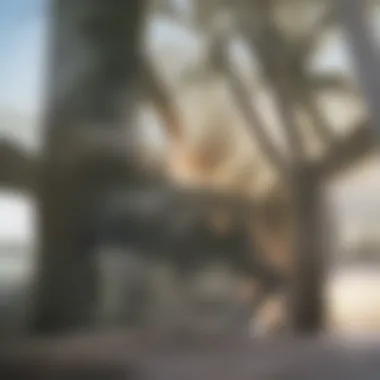Explore the Most Beautiful Places in Miami


Intro
Miami is not merely a destination; it is a celebration of life, culture, and beauty. Its stunning landscape invites visitors and locals alike to immerse themselves in numerous visual experiences. The city boasts distinct neighborhoods showcasing a variety of attractions, from its crystal-clear beaches to lush botanical gardens. This article delves into the heart of Miami’s charm, mapping out some key places which distinguish its captivating environment.
Architectural Inspiration
Overview of Design Styles
Miami presents a unique architectural palette influenced by various cultures and historical contexts. The Art Deco district stands as a testament to the city’s vibrant history, marked by pastel colors and geometric shapes. Walking along Ocean Drive, visitors can appreciate these buildings, which create an iconic skyline that merges history with modern entertainment.
The Mediterranean Revival style also features prominently. Homes with tile roofs and arched windows reflect a timeless elegance. These designs create a welcoming ambiance, highlighting the area’s warm climate and cultural diversity.
Innovative Materials and Techniques
In Miami, architecture goes beyond traditional materials. Many buildings utilize glass to invite natural light, capturing the scenic views while providing energy efficiency. Structures often integrate sustainable materials, promoting environmental responsibility. The use of bold colors reflects the region’s cultural vibrance, creating a dialogue between nature and built environments.
For real estate enthusiasts, understanding these architectural trends is crucial. Buyers often seek properties that encapsulate local aesthetics coupled with modern functionality.
Interior Design Trends
Color Schemes and Their Psychological Effects
In the realm of interior design, Miami exhibits a preference for colors that resonate with its environment. Shades of turquoise evoke calmness reminiscent of the ocean, while brighter yellows and oranges reflect the city's lively spirit. These choices have psychological implications; warmer tones create invitations for social interactions, while cooler palettes encourage relaxation.
Space Optimization Tips
Miami's real estate often consists of compact apartments that necessitate clever space usage. Here are a few tips:
- Use multifunctional furniture: Items that serve dual purposes can save space.
- Maximize vertical space: Shelves and wall-mounted pieces take advantage of the height of the room.
- Create open areas: An open layout fosters movement and enhances the feeling of space.
As urban living increases in popularity, these trends are pivotal for both homeowners and designers aiming to make the most of limited square footage.
"Miami's architectural diversity is an essential part of its identity. It offers a glimpse into its past while also embracing the future."
Every stunning corner of Miami provides richness in visual aesthetics and cultural significance, making it a landmark destination for anyone who seeks beauty and inspiration.
Intro to Miami’s Aesthetic Appeal
Miami, Florida is a city that captivates with its rich aesthetic engagement, influenced by various cultural elements and a unique architectural landscape. Understanding Miami’s aesthetic appeal is essential for appreciating what makes this city distinct. It combines influences from multiple cultures, showcasing a diversity that enhances its visual identity. The blend of art, design, and nature is what gives Miami its charm. This section dissects critical aspects, notably cultural influences and architectural diversity, providing a foundation for understanding the broader beauty of Miami.
Cultural Influences on Miami’s Landscape
Miami’s landscape is a rich tapestry woven from numerous cultural threads. The city's history is marked by the contributions of various immigrant groups, each bringing their traditions, art, and architectural styles. Caribbean, Latin American, and European influences all left their marks, creating a unique and vibrant city. Areas like Little Havana are emblematic of the Cuban influence, where colorful murals and cultural festivals showcase the essence of Miami.
Notably, the art scene thrives on this cultural cocktail. The Wynwood Walls transformed the warehouse district into a vibrant canvas, displaying works from artists worldwide. This is not just art on walls but a reflection of the cultural fusion inherent in Miami. These influences enrich the urban experience, making Miami more than just a city—it is a living gallery of global contributions.
Architectural Diversity in Miami
Miami's architectural landscape is a striking contrast of styles. The famous Art Deco architecture of South Beach stands as a testament to the city's historical significance. These pastel-colored buildings, with their geometric shapes, tell stories of the roaring twenties and give the area its distinctive character.
On the other hand, modern constructions like the Porsche Design Tower highlight the city's shift towards luxury and innovation. This blend of old and new paves the way for a seamless visual experience that attracts architects and designers alike. Having various architectural influences makes the visual dynamics of Miami intriguing.


- Key Characteristics of Miami’s Architecture:
- Art Deco: Colorful, geometric patterns.
- Mediterranean Revival: Arches and ornate details.
- Modern and Contemporary: Sleek lines and innovative materials.
This diverse architectural framework not only serves functional purposes but also acts as a reflection of Miami's evolution over the years.
Miami’s beauty lies in its cultural and architectural diversity, which creates a living experience that is continuously evolving.
Iconic Beaches of Miami
Miami’s iconic beaches represent a crucial aspect of the city's allure. They offer not only stunning vistas but also a sense of the vibrant lifestyle that characterizes the area. These beaches provide a myriad of recreational activities, ranging from swimming and sunbathing to water sports and beachside dining. Understanding the beauty and charm of these locations is essential for anyone looking to fully appreciate Miami's coastal offerings.
South Beach
South Beach is perhaps the most famous stretch of sand in Miami. Its lively atmosphere attracts locals and tourists alike. South Beach features Art Deco architecture lining the beachfront, giving it a unique aesthetic. This area is not just a destination for sunbathers; it is a cultural hub filled with cafes and shops, making it a great spot for socializing. Visitors often find themselves captivated by the colorful lifeguard stands and the broad walkways, ideal for strolling and people-watching. The beach itself is clean and well-maintained, offering warm waters that invite a refreshing swim.
Key Biscayne
Key Biscayne is another remarkable beach destination. This beach provides a more tranquil experience compared to the bustling South Beach. The area is abundant with natural beauty, featuring lush green parks and serene waters. Crandon Park is notable here, offering picnic areas and bike paths. As a result, families often flock to Key Biscayne for a day of relaxation. For those who seek adventure, kayaking and paddleboarding are popular activities in these calmer waters. The experiences at Key Biscayne promote a deeper appreciation of nature while still enjoying the coastal environment.
Haulover Beach
Haulover Beach stands out due to its spaciousness and scenic beauty. This beach is renowned for its soft, white sand and clear blue skies. It also has designated areas for specific activities, such as kite flying and picnicking. One of the unique aspects of Haulover Beach is its clothing-optional section, which adds an interesting dimension to the beach experience. For those who prefer a more conventional beach day, there are plenty of family-friendly spots available. The ambiance here is relaxed, providing a perfect setting to unwind away from the more crowded areas of Miami.
Miami’s beaches are not only destinations for leisure; they are also integral to the city’s cultural and social landscape.
In summary, the beach experiences offered in Miami each have their unique character. From the vibrant energy of South Beach to the calm vibes at Key Biscayne and the open spaces of Haulover Beach, these locations embody the essence of Miami's coastal charm. Whether you are searching for a livelier scene or a peaceful getaway, Miami's iconic beaches have something special to offer for every visitor.
Art and Culture in Miami
Miami’s art and culture scene is pivotal to understanding the social fabric of the city. It offers a vivid illustration of the diverse influences that shape its identity. The importance of art and culture in Miami lies not only in its role as a creative outlet but also as a means of communication among various communities. Visitors can experience this through murals, art galleries, and cultural events that highlight history and contemporary expression. By appreciating Miami's art scene, one gains insight into the lives, struggles, and triumphs of the people who inhabit this vibrant city.
Wynwood Walls
Wynwood Walls represents a celebrated focal point for street art enthusiasts. This open-air gallery is home to enormous murals crafted by international artists. It has transformed the Wynwood neighborhood into a vibrant hub, attracting both locals and tourists. Each mural tells a unique story, reflecting social issues or personal narratives.
Visiting Wynwood Walls offers more than just visual pleasure. It provides a space where cultural dialogues occur. The community around it often engages in various activities, including art workshops and live painting events, further enriching the visitor experience. This creativity helps to foster a sense of belonging and pride among residents.
Perez Art Museum Miami
The Perez Art Museum Miami, often referred to as PAMM, is a beacon of contemporary art in the city. Its architecture seamlessly blends with the natural surroundings and Biscayne Bay. Visitors find a diverse collection focused on international art from the 20th and 21st centuries. Notably, the museum emphasizes works by artists from the Americas, making its collection distinct.
PAMM goes beyond displaying art; it provides educational programs and workshops aimed at promoting appreciation for contemporary art. Such initiatives help to engage visitors of all ages, fostering a culture of learning and participation.
Little Havana’s Street Art
Little Havana serves as the heart of Miami's Cuban culture. The vibrant street art here encapsulates the community's heritage and diverse stories. Intricate murals adorn buildings, often depicting pivotal moments from Cuban history alongside contemporary influences.
Visitors can walk along Calle Ocho, experiencing the energy of the area. The artwork not only beautifies the space but also encourages conversations about identity and tradition. Cultural festivals, such as the Calle Ocho Festival, further showcase the area’s artistic flair, bringing together music, dance, and food to celebrate Cuban heritage.
The art in Little Havana is a living narrative, constantly evolving as new stories emerge and old traditions are celebrated.
Natural Beauty in Miami


Miami's natural beauty plays a significant role in defining the essence of this vibrant city. The lush landscapes, fragrant flora, and serene bodies of water offer both residents and visitors a tranquil escape from the urban hustle. Miami boasts diverse ecosystems that not only contribute to its scenic appeal but also provide essential habitat for wildlife, making it a haven for nature enthusiasts.
Understanding its natural beauty allows one to appreciate the balance between urban development and preserving natural spaces. Green spaces in Miami serve multiple purposes, from enhancing quality of life to contributing to the city's climate resilience. The intersection of man-made and natural beauty creates a unique aesthetic that distinguishes Miami from other cities.
Fairchild Tropical Botanic Garden
The Fairchild Tropical Botanic Garden is a premier living museum located in Coral Gables, spanning 83 acres. This garden is a testament to the diversity of plant life, showcasing thousands of species, including tropical fruit trees, palms, and flowering plants. The garden plays a critical role in conservation and education. Visitors can explore various themed areas, such as the Rainforest Exhibit and the Butterfly Garden.
Exhibits change seasonally, providing reasons to return. The garden serves as an important research center focused on plant conservation, attracting scholars and enthusiasts alike. Its tranquil environment is perfect for reflective strolls, photography, or simply enjoying nature.
Everglades National Park
Everglades National Park represents a unique ecosystem, home to diverse wildlife and plant species. This vast wetland is one of the largest subtropical wildernesses in the world and is recognized as a UNESCO World Heritage Site. The park is crucial for its environmental protection and is a significant area for biodiversity. Visitors can engage in activities such as airboat tours, hiking, and birdwatching.
The beauty of the Everglades lies in its untouched landscapes—mangroves, sawgrass prairie, and slow-moving waters. These features provide habitats for endangered species like the Florida panther and the American crocodile. Visiting the park offers a firsthand experience of nature’s majesty, emphasizing the importance of conservation efforts.
Matheson Hammock Park
Matheson Hammock Park is a hidden gem in Miami, known for its lush greenery and picturesque lagoon. The park extends over 630 acres, featuring walking trails and picnic areas that attract families and nature lovers. Its man-made atoll pool is ideal for swimming, surrounded by coconut palms and sandy beaches. The calming setting makes it a perfect spot for relaxation away from city life.
In addition to its recreational offerings, the park is a popular location for birdwatching and kayaking. A network of trails encourages exploration of the natural surroundings, making it an excellent choice for both casual visitors and more experienced outdoor adventurers. Matheson Hammock Park showcases the harmonious relationship between urban living and nature, embodying Miami’s commitment to preserving its natural areas.
Scenic Waterfronts
Miami's waterfronts are integral to the city’s allure. They not only provide breathtaking views but also serve as key locations for recreation and relaxation. The interplay between water, city skyline, and natural landscapes creates a unique atmosphere that enhances the quality of life for residents and visitors alike. Enjoying Miami’s waterfronts allows individuals to connect with nature, engage in various activities, and appreciate the city’s picturesque skyline.
Biscayne Bay
Biscayne Bay is a stunning body of water that defines much of Miami’s eastern coastline. It is known for its clear blue waters and diverse marine life. This bay serves as a crucial habitat for various species, including manatees and dolphins. Residents and tourists alike can partake in a multitude of activities around the bay. Those who enjoy boating, kayaking, or paddleboarding will find Biscayne Bay particularly appealing.
Along the shores, numerous parks and recreational spaces exist. Places like Matheson Hammock Park offer scenic picnic areas, while Crandon Park delivers both beaches and nature trails. The bay is also vital for ecological preservation, hosting the Biscayne National Park.
"Biscayne Bay is not just a beautiful sight but an ecological treasure that nurtures life in many forms."
Miami River Walk
The Miami River Walk is a mixed-use pathway that runs along the banks of the Miami River. This beautiful walk connects various neighborhoods and provides easy access to parks, restaurants, and cultural locations. The river’s banks are lined with lush greenery that offers a welcome contrast to the urban environment.
Walking along the Miami River Walk enhances appreciation for the city’s blend of nature and modernity. It is an ideal spot for joggers, cyclists, or those looking to enjoy a casual stroll. The river hosts multiple recreational activities, allowing for fishing or paddle boating, thereby encouraging community interaction.
Virginia Key
Virginia Key is an island located just south of Miami Beach, known for its tranquil beaches and lush areas. It offers an escape from the bustling city life. Visitors can enjoy the pristine waters, often less crowded than other beaches, making it a perfect spot for relaxation.
The island is also home to the famous Virginia Key Beach Park, which has historical significance and recreational amenities. Here, travelers can swim, sunbathe, or partake in outdoor activities like cycling along its scenic paths. Furthermore, the Virginia Key Nature Preserve is a must-see for nature lovers, offering trails and wildlife observation opportunities.
Overall, Miami's scenic waterfronts, from the vibrant Biscayne Bay to the peaceful Virginia Key, illustrate the city’s beauty. These spaces facilitate recreation and connect residents to nature. Enjoying these waterfronts enriches the Miami experience for both locals and tourists.
Historical Sites and Districts
Miami's historical sites and districts offer a distinctive look into its past. They provide a context to the city’s rich cultural tapestry, showcasing events and influences that shaped Miami. These locations are essential not only for their historical value but also for their architectural significance and influence on local culture. By exploring these sites, one gains a deeper understanding of Miami's evolution and its diverse identity.
Art Deco Historic District


The Art Deco Historic District is perhaps the most visually striking example of Miami’s architectural uniqueness. Established in the 1920s and 1930s, this neighborhood features over 800 buildings showcasing the Art Deco style. The pastel colors and geometric shapes are characteristic of this era. Walking through Ocean Drive, one can observe the intricate details of the buildings, which often incorporate neon lights and decorative motifs.
This district not only highlights architectural beauty but also reflects the social and historical context of the time. The preservation of the Art Deco design has become a model for revitalization efforts in other cities. Visitors often appreciate the aesthetic value while also learning about the cultural shifts that led to the development of this district.
Freedom Tower
The Freedom Tower serves as a monument of hope and resilience. Built in 1925, it originally served as the Miami News building. Today, it is known as a central point in Miami's Cuban community, as it housed many Cuban refugees during the Mariel Boatlift in 1980. The tower's Mediterranean Revival style stands in contrast with the modern skyline that has emerged around it.
This iconic building is more than just a landmark; it tells a story of migration and the struggles faced by the Cuban population. The Freedom Tower now serves as a museum, providing educational resources that detail its historical and cultural significance. For those interested in the intersection of history and community, this site is essential.
Coconut Grove
Coconut Grove is one of Miami's oldest neighborhoods, founded in the late 1800s. Its historical roots are rich with tales of early settlers and the burgeoning community. The area retains a bohemian vibe, contrasted by various architectural styles, from modern homes to historic residences.
Coconut Grove is also home to historical sites like the Barnacle Historic State Park, which features the oldest home in Miami-Dade County. The stunning waterfront and lush greenery make this neighborhood a poetic retreat in Miami. With art galleries, quaint shops, and vibrant street life, it’s a delightful blend of nature and culture. Each visit to Coconut Grove reveals layers of history, appealing to those who appreciate both the past and the present.
Culinary and Nightlife Scenes
The culinary and nightlife scenes in Miami are vibrant and eclectic. They are essential in showcasing the city's multicultural identity. Miami's dining options reflect influences from Latin America, the Caribbean, and beyond. This culinary diversity plays a significant role in attracting food enthusiasts from all over. Moreover, the nightlife contributes to Miami's reputation as a cosmopolitan hub.
Outdoor Dining Experiences
Outdoor dining is an essential part of Miami's culinary landscape. Shady palm trees and ocean breezes create the perfect atmosphere for enjoying meals al fresco. Many restaurants offer outdoor seating that allows diners to savor their food while soaking in the beautiful surroundings. Notable venues include Joe's Stone Crab, known for its fresh seafood and bustling terrace. Another excellent choice is the Wynwood Kitchen & Bar, which combines art with a diverse menu, allowing guests to enjoy a unique ambiance.
Benefits of outdoor dining include:
- Enjoying fresh air and scenic views
- Discovering local flavors in a unique setting
- Socializing with friends and family in a lively atmosphere
Rooftop Bars with Stunning Views
Miami boasts numerous rooftop bars that provide breathtaking views of the skyline and coastline. These elevated venues enhance the experience of enjoying a drink while overlooking the city. Places like Edge Steak & Bar at the Four Seasons offer not only expertly crafted cocktails but also unparalleled cityscapes. The Sugar Rooftop Bar in Brickell brings Asian flavors to its cocktail menu, along with a fantastic panoramic view of downtown Miami.
Rooftop bars serve as gathering places, perfect for celebrations or quiet evenings. The combination of ambiance and stunning vistas creates a memorable experience.
Cultural Food Festivals
Miami hosts numerous cultural food festivals that reflect its diversity. These events highlight various cuisines, introducing attendees to new dishes and flavors. Festivals such as the Miami Rum Renaissance Festival focus on rum-based beverages and Caribbean flavors. In contrast, the Yuca Festival celebrates traditional Latin dishes, showcasing the rich heritage of the community.
Participating in these festivals allows visitors to enjoy:
- A range of authentic dishes and drinks
- Cultural performances and entertainment
- Opportunities to learn about local food traditions
In summary, Miami's culinary and nightlife scenes encapsulate the city's charm. Restaurants, bars, and food festivals create a rich tapestry that caters to diverse tastes. For those exploring the city, these experiences provide not just sustenance but also a deeper understanding of Miami's culture.
End: The Essence of Miami’s Beauty
The examination of Miami’s unique beauty reveals a multifaceted city with much to offer. Each section of this article has explored various locations that highlight the visual splendor and cultural richness found throughout Miami. From its iconic beaches to lush gardens, Miami serves as a testimony to diverse influences and vibrant lifestyles. As you navigate through these beautiful places, consider how they contribute to Miami’s overall charm and appeal.
Understanding the essence of Miami requires appreciating its blend of natural beauty and architectural aesthetics. The juxtaposition of urban landscapes and serene waterfronts creates an enticing environment for both residents and visitors. Moreover, Miami’s cultural mosaic manifests in its art, cuisine, and traditions, enriching every experience.
Benefits of Exploring Miami’s Beauty
- Cultural Depth: Each location tells a story through its history and artistic expression.
- Visual Inspiration: The vibrant colors and unique designs stimulate creativity and appreciation for beauty.
- Community Engagement: Participating in local events fosters a sense of belonging and connection.
As we conclude, it is essential to reflect on how these beautiful places contribute to quality of life. The accessibility of such diverse environments allows both relaxation and exploration. Moreover, they enhance Miami’s reputation as not just a destination, but a place to experience life fully.
"Miami is more than a city; it's a tapestry of cultures woven into breathtaking aesthetics."
Consider how the information presented throughout this article can inspire your future visits or possibly influence your choices in real estate or design. Miami is, without question, a city where beauty resonates in every corner, waiting to be discovered.







